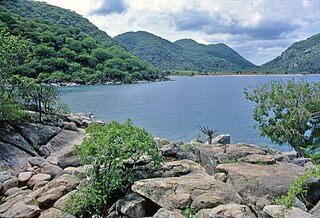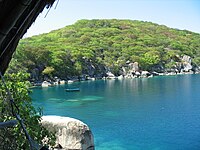
Malawi, officially the Republic of Malawi and formerly known as Nyasaland, is a landlocked country in Southeastern Africa. It is bordered by Zambia to the west, Tanzania to the north and northeast, and Mozambique to the east, south and southwest. Malawi spans over 118,484 km2 (45,747 sq mi) and has an estimated population of 19,431,566. Malawi's capital and largest city is Lilongwe. Its second-largest is Blantyre, its third-largest is Mzuzu and its fourth-largest is Zomba, the former capital.

Lake Malawi, also known as Lake Nyasa in Tanzania and Lago Niassa in Mozambique, is an African Great Lake and the southernmost lake in the East African Rift system, located between Malawi, Mozambique and Tanzania.

Southern Africa is the southernmost region of Africa. No definition is agreed upon, but some groupings include the United Nations geoscheme, the intergovernmental Southern African Development Community, and the physical geography definition based on the physical characteristics of the land.

The Tumbuka is a Bantu ethnic group found in Malawi, Zambia and Tanzania. Tumbuka is classified as a part of the Bantu language family, and with origins in a geographic region between the Dwangwa River to the south, the North Rukuru River to the north, Lake Malawi to the east, and the Luangwa River. They are found in the valleys near the rivers, lake as well as the highlands of Nyika Plateau, where they are frequently referred to as Henga although this is strictly speaking the name of a subdivision.

Karonga is a township in the Karonga District in Northern Region of Malawi. Located on the western shore of Lake Nyasa, it was established as a slaving centre sometime before 1877. As of 2018 estimates, Karonga has a population of 61,609. The common and major language spoken in this district is the Tumbuka language, which is also a regional language of Northern Malawi.

Nkhotakota (Un-kho-tah-kho-tuh) is a town and one of the districts in the Central Region of Malawi. It is on the shore of Lake Malawi and is one of the main ports on Lake Malawi. As of 2018, Nkhotakota had a population estimated at 28,350. The district had a population of 301,000.

Wild Life is the debut studio album by the British-American rock band Wings and the third studio album by Paul McCartney after the breakup of the Beatles. The album was mainly recorded in seven sessions between 24 July and 4 September 1971, at EMI Studios by McCartney, his wife Linda, session drummer Denny Seiwell, whom they had worked with on the McCartneys' previous album Ram, and guitarist Denny Laine, formerly of the English rock band the Moody Blues. It was released by Apple Records on 7 December in the UK and US, to lukewarm critical and commercial reaction.

Mumbo jumbo, or mumbo-jumbo, is confusing or meaningless language. The phrase is often used to express humorous criticism of middle-management, and specialty jargon, such as legalese, that non-specialists have difficulty in understanding. For example, "I don't understand all that legal mumbo jumbo in the fine print."
Liwonde National Park, also known as Liwonde Wildlife Reserve, is a national park in southern Malawi, near the Mozambique border. The park was established in 1973, and has been managed by the nonprofit conservation organization African Parks since August 2015. African Parks built an electric fence around the perimeter of the park to help mitigate human-wildlife conflict. In early 2018, the adjacent Mangochi Forest Reserve was also brought under African Parks' management, almost doubling the size of the protected area.

Lake Malawi National Park is a national park at the southern end of Lake Malawi in Malawi, Southeast Africa. It is the only national park in Malawi that was created with the purpose of protecting fish and aquatic habitats. Despite this being its main purpose, Lake Malawi National Park includes a fair amount of land, including a headland, the foreshore and several small rocky islands in Lake Malawi.

Nkhata Bay or just Nkhata is the capital of the Nkhata Bay District in Malawi. It is on the shore of Lake Malawi, east of Mzuzu, and is one of the main ports on Lake Malawi. The population of Nkhata Bay was 14,274 according to the 2018 census. Nkhata Bay is 413 kilometres (257 mi) from Lilongwe, Malawi's capital city, and 576 kilometres (358 mi) from Blantyre, Malawi's second-largest city. Nkhata Bay is the second "busiest resort" on Lake Malawi.

Islam is the second largest religion in Malawi behind Christianity. Nearly all of Malawi's Muslims adhere to Sunni Islam. Though difficult to assess, according to the CIA Factbook, in 2018 about 13.8% of the country's population was Muslim. Muslim organisations in the country claim a figure of 15-20%. According to the latest census (2018), Muslims make up 13.8% (2,426,754) of the country's population. According to the Malawi Religion Project run by the University of Pennsylvania, in 2010 approximately 19.6% of the population was Muslim, concentrated mostly in the Southern Region.

Hinduism in Malawi arrived when Indian colonists and mercantilists were brought by the colonial British administrators in the late 19th and early 20th-century in what was then known as British Central Africa and later Nyasaland. They were a part of a global movement of workers to parts of East Africa, to help build infrastructure projects, establish services, retail markets and for administrative support. The immigrants, some educated and skilled but mostly poor and struggling in famine prone areas of Punjab, Gujarat, Uttar Pradesh, Bihar and West Bengal, helped construct the first railway line between Malawi and Mozambique.

Cape Maclear or Chembe is a town in the Mangochi District of Malawi's Southern Region. The town, on the Nankumba Peninsula, is on the southern shore of Lake Malawi and is the busiest resort on Lake Malawi. Cape Maclear is close to the islands of Domwe, Thumbwe and Mumbo Island on Lake Malawi, and is in Lake Malawi National Park.

The wildlife of Malawi is composed of the flora and fauna of the country. Malawi is a landlocked country in southeastern Africa, with Lake Malawi taking up about a third of the country's area. It has around 187 species of mammal, some 648 species of birds have been recorded in the country and around 500 species of fish, many of them endemic, are found in its lakes and rivers. About 20% of the country has been set aside as national parks and game and forest reserves.

Frank Mkalawile Chipasula is a Malawian writer, editor and university professor, "easily one of the best of the known writers in the discourse of Malawian letters".

The Universities' Mission to Central Africa was a missionary society established by members of the Anglican Church within the universities of Oxford, Cambridge, Durham, and Dublin. It was firmly in the Anglo-Catholic tradition of the Church, and the first to devolve authority to a bishop in the field rather than to a home committee. Founded in response to a plea by David Livingstone, the society established the mission stations that grew to be the bishoprics of Zanzibar and Nyasaland, and pioneered the training of black African priests.

The Sena people are a Bantu ethnolinguistic group with origins in northwestern region of Mozambique, Sofala Province and Zambezia Province. They are also found in Malawi and Zimbabwe near their respective borders with Mozambique.
Mumboism, also known as the Mumbo cult, was a new religious movement founded by Onyango Dunde in the early 20th century. Followers of the religion, known as Mumboites, were most active in the Nyanza region of Kenya near Lake Victoria. The movement had anti-imperial teachings and was suppressed by the colonial government of Kenya.

Southeast Africa, or Southeastern Africa, is an African region that is intermediate between East Africa and Southern Africa. It comprises the countries Botswana, Eswatini, Kenya, Lesotho, Malawi, Mozambique, Namibia, Rwanda, South Africa, Tanzania, Uganda, Zambia and Zimbabwe in the mainland, with the island-nations of Madagascar, Mauritius, Comoros, and Seychelles also included.



















